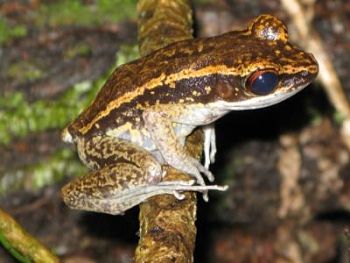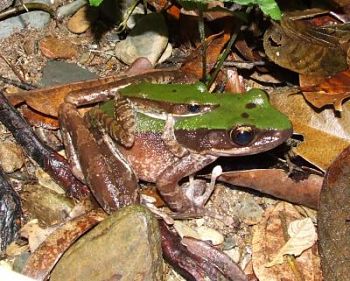
La página que intenta visitar sólo está disponible en inglés. ¡Disculpa!
The page you are about to visit is currently only available in English. Sorry!


Of all the amphibians sampled, this Philippino frog had the highest infection rate. Credit: R. Brown
We’ve heard the horror stories: a deadly amphibian fungal disease called chytridiomycosis is sweeping through the world’s bogs and swamps, claiming the lives of untold numbers of frogs, newts, and salamanders in its wake. Batrachochytrium dendrobatidis, the fungal culprit also known as Bd, has already ended the existence of over 200 amphibian species in Australia, Europe, and the Americas. Conspicuously missing from the body count, though, are Asian amphibians, though the Eastern continent claims some of the greatest amphibian diversity in the world.
Over 25 researchers hailing from institutes ranging from the U.S. to Laos to Switzerland combined efforts to shed light in the Asian amphibian mystery. Some suspect that Bd’s non-presence in Asia is simply a byproduct of the continent being under-studied, so the team set off to complete a major survey of the Asian nations. Their efforts, which spanned eight years and took them to 15 countries, were published in August in PLoS One. All in all, they documented over 3,000 amphibians and their health status. They hope that these new records will begin to fill the Asian “black hole” in Bd data.
The results were encouraging: only 2.2 percent of the animals sampled registered positive for Bd. All 74 cases of the disease were documented in frogs, though the researchers warn that their salamander sample group wasn’t large enough to exclude the possibility that infected salamanders could be present somewhere in Asia. Cases of infection were widely dispersed with no apparent country-to-country pattern. The only countries that hosted the disease were the Philippines, Kyrgyzstan, Laos, Indonesia, Malaysia, and South Korea.

This Lao frog species also suffered from fungal infections. Credit: Bryan L. Stuart
Much of the natural environment in Asia seems conducive for Bd, so why has the continent so far been spared from the amphibian plague? The researchers have three hunches. The first, and most worrisome, is simply that Bd has not yet emerged in Asian environments. Analyzing the geographic distribution of the places where Bd did turn up, though, doesn’t point towards normal emerging disease patterns. On the other hand, Bd could be native to the Asian environment, meaning local amphibian species could have built up an evolutionary resistance to the normally devastating disease. Finally, it could be that Bd has tried to rear its head in Asia, but that some unknown factor in the nature is preventing the fungus from taking hold. Microbes on Asian amphibians’ skin, for example, could be saving their hosts from the disease.
Though things seem rosy for Asian amphibians, the lack of explanation is worrisome. The research team acknowledges that much more data are needed in order to fully assess and understand the Bd threat to amphibians in the Far East. Given the complexity of natural environments, small changes in temperature due to climate change, for example, could be enough to tip the scales in favor of Bd’s emergence onto the Asian amphibian scene. Following populations of Asian amphibians to see how Bd changes over time would be one way to elucidate the mystery. The scientists also propose analyzing the genetics of Bd strains found in different parts of the world to see if they differ in virulence.
If Bd were to emerge in Asia, the researchers predict that the Philippines would be the first hot spot since it currently has the highest Bd prevalence, with 33 frogs strongly testing positive for the disease. The biologists noted that the patterns of infection found in the Philippines resemble Bd in its first outbreaks in California and Central and South America, though hopefully these signs will never come to deadly fruition.
Worldwide, Bd has caused a decline in 42 percent of amphibian species, threatening 32 percent with total annihilation. The fungus, which disrupts the function of amphibians’ skin, now ranks as the disease causing the greatest loss in vertebrate biodiversity in recorded history.